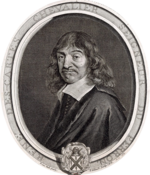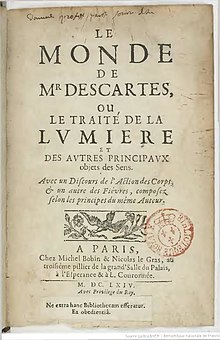This article needs additional citations for verification. (November 2011) |
| Part of a series on |
| René Descartes |
|---|
 |

The World, also called Treatise on the Light (French title: Traité du monde et de la lumière), is a book by René Descartes (1596–1650). Written between 1629 and 1633, it contains a nearly complete version of his philosophy, from method, to metaphysics, to physics and biology.
Descartes espoused mechanical philosophy, a form of natural philosophy popular in the 17th century. He thought everything physical in the universe to be made of tiny "corpuscles" of matter. Corpuscularianism is closely related to atomism. The main difference was that Descartes maintained that there could be no vacuum, and all matter was constantly swirling to prevent a void as corpuscles moved through other matter. The World presents a corpuscularian cosmology in which swirling vortices explain, among other phenomena, the creation of the Solar System and the circular motion of planets around the Sun.
The World rests on the heliocentric view, first explicated in Western Europe by Copernicus. Descartes delayed the book's release upon news of the Roman Inquisition's conviction of Galileo for "suspicion of heresy" and sentencing to house arrest. Descartes discussed his work on the book, and his decision not to release it, in letters with another philosopher, Marin Mersenne.[1]
Some material from The World was revised for publication as Principia philosophiae or Principles of Philosophy (1644), a Latin textbook at first intended by Descartes to replace the Aristotelian textbooks then used in universities. In the Principles the heliocentric tone was softened slightly with a relativist frame of reference. The last chapter of The World was published separately as De Homine (On Man) in 1662. The rest of The World was finally published in 1664, and the entire text in 1677.
- ^ Gaukroger, Stephen (2004). Descartes an intellectual biography (Repr., paperback ed.). Oxford: Oxford University Press. ISBN 0198237243.